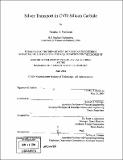Silver transport in CVD silicon carbide
Author(s)
MacLean, Heather J. (Heather Jean), 1974-
DownloadFull printable version (7.656Mb)
Alternative title
Silver transport in chemical vapor deposition silicon carbide
Other Contributors
Massachusetts Institute of Technology. Dept. of Nuclear Engineering.
Advisor
Ronald G. Ballinger.
Terms of use
Metadata
Show full item recordAbstract
Ion implantation and diffusion couple experiments were used to study silver transport through and release from CVD silicon carbide. Results of these experiments show that silver does not migrate via classical diffusion in silicon carbide. Silver release is, however, likely dominated by vapor transport through cracks in SiC coatings. The results of silver ion implantation in silicon carbide and subsequent annealing at 1500ʻC place an upper limit on the silver diffusion coefficient in SiC of 5x10-21 m2/s, a value which is roughly 6 orders of magnitude less than the previous values reported in the literature. Silver diffusion should have been easily observable, but was not detected in SiC plates after heat treatments at 1500ʻC for times ranging between 200 h and 500 h. A detailed investigation of the silver morphology within the SiC both before and after heating showed that silver was immobilized at SiC grain boundaries and did not diffuse along them as expected. Novel spherical diffusion couples were fabricated containing silver inside shells of either graphite or SiC which were coated with CVD SiC. Mass measurements clearly revealed silver release from the diffusion couples after heating, but no silver was detected during concentration profile measurements in the SiC. Leak testing results, however, gave evidence of the presence of cracks in many of the SiC coatings, which may have provided pathways for silver escape. A simple vapor flow model was applied to estimate crack sizes that would account for silver release from SiC coatings in the current diffusion couples and coated fuel particle tests from the literature. (cont.) These calculated crack sizes are small enough that they would not have been detected during normal investigation or post-irradiation examination. A diffusive mechanism has been assumed to control silver transport in silicon carbide based on silver release observations reported previously in the literature, but no direct evidence of silver diffusion has been offered. Additionally, variations in silver release from particle to particle indicate that silver transport does not occur equally in all silicon carbide samples and is not consistent with diffusion. The findings presented in this dissertation are important to coated particle fuel design and fabrication because they indicate that SiC can successfully retain silver but that some SiC coatings permit silver release. Future work must be directed at identifying the pathways for silver release and their root causes in order to prevent silver release from coated fuel particles.
Description
Thesis (Ph. D.)--Massachusetts Institute of Technology, Dept. of Nuclear Engineering, 2004. Includes bibliographical references.
Date issued
2004Department
Massachusetts Institute of Technology. Department of Nuclear Engineering; Massachusetts Institute of Technology. Department of Nuclear Science and EngineeringPublisher
Massachusetts Institute of Technology
Keywords
Nuclear Engineering.